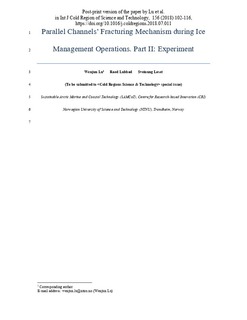| dc.contributor.author | Lu, Wenjun | |
| dc.contributor.author | Lubbad, Raed | |
| dc.contributor.author | Løset, Sveinung | |
| dc.date.accessioned | 2019-04-02T07:02:38Z | |
| dc.date.available | 2019-04-02T07:02:38Z | |
| dc.date.created | 2018-12-06T14:35:58Z | |
| dc.date.issued | 2018 | |
| dc.identifier.citation | Cold Regions Science and Technology. 2018, 156 117-133. | nb_NO |
| dc.identifier.issn | 0165-232X | |
| dc.identifier.uri | http://hdl.handle.net/11250/2592806 | |
| dc.description.abstract | During ice management operations, cutting parallel channels with narrow spacing in the ice using icebreakers can effectively reduce the size of ice floes reaching the protected vessel/structure. A narrow channel spacing width generates smaller ice floes. However, a spacing that is too narrow can lead to excessive or even impractical ice management operations. Therefore, it is beneficial to establish a theoretical model that correlates the channel spacing width with the frequency of ice fracturing events and the reduction of managed ice floe sizes. This is achieved in the current study with two sequential papers, i.e. Papers I and II. In Paper I, a theoretical model involving an ‘edge crack model’ was formulated to predict the following conditions for an ice management operation: 1) the maximum ice floe with size LMCD that can be produced; 2) the maximum channel spacing width hmax beyond which long cracks will not develop between the channels; and 3) the required force to initiate long cracks between parallel channels. In this paper (Paper II), we describe two dedicated ‘parallel channel tests’ conducted separately on September 26th and 29th in 2015 during an expedition to the Arctic Ocean (around 82°N and 16°E) with the icebreakers Oden and Frej. The tests had ‘well-controlled’ channel spacing in each test run. Several different channel spacing values were tested with the Oden and the consequent fracturing information was documented by camera images. Image processing enabled us to extract information, such as maximum floe sizes and floe size distributions, given different channel spacing widths. In addition, the ship's data, such as ship velocity and propulsion history, enabled us to validate the theoretical model's capability to predict the onset of long cracks between two parallel channels. Despite uncertainties (e.g., non-uniform ice thickness, fracture properties of sea ice, etc.) involved in the tests, favourable comparisons between the experimental results and the theoretical predictions were achieved. Both the theoretical model and experimental results help clarify the parallel channel fracturing mechanism. | nb_NO |
| dc.language.iso | eng | nb_NO |
| dc.publisher | Elsevier | nb_NO |
| dc.rights | Attribution-NonCommercial-NoDerivatives 4.0 Internasjonal | * |
| dc.rights.uri | http://creativecommons.org/licenses/by-nc-nd/4.0/deed.no | * |
| dc.title | Parallel channels' fracturing mechanism during ice management operations. Part II: Experiment | nb_NO |
| dc.type | Journal article | nb_NO |
| dc.type | Peer reviewed | nb_NO |
| dc.description.version | acceptedVersion | nb_NO |
| dc.source.pagenumber | 117-133 | nb_NO |
| dc.source.volume | 156 | nb_NO |
| dc.source.journal | Cold Regions Science and Technology | nb_NO |
| dc.identifier.doi | 10.1016/j.coldregions.2018.07.011 | |
| dc.identifier.cristin | 1639940 | |
| dc.relation.project | Norges forskningsråd: 203471 | nb_NO |
| dc.description.localcode | © 2018. This is the authors’ accepted and refereed manuscript to the article. Locked until 23. July 2020 due to copyright restrictions. This manuscript version is made available under the CC-BY-NC-ND 4.0 license http://creativecommons.org/licenses/by-nc-nd/4.0/ | nb_NO |
| cristin.unitcode | 194,64,91,0 | |
| cristin.unitname | Institutt for bygg- og miljøteknikk | |
| cristin.ispublished | true | |
| cristin.fulltext | original | |
| cristin.qualitycode | 2 | |

